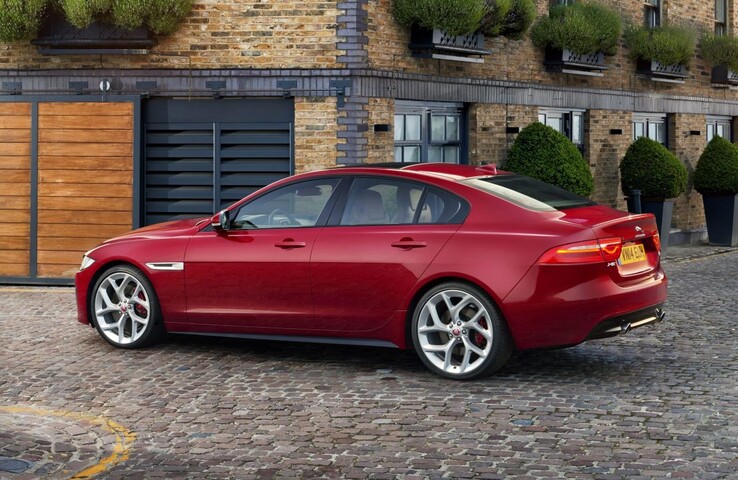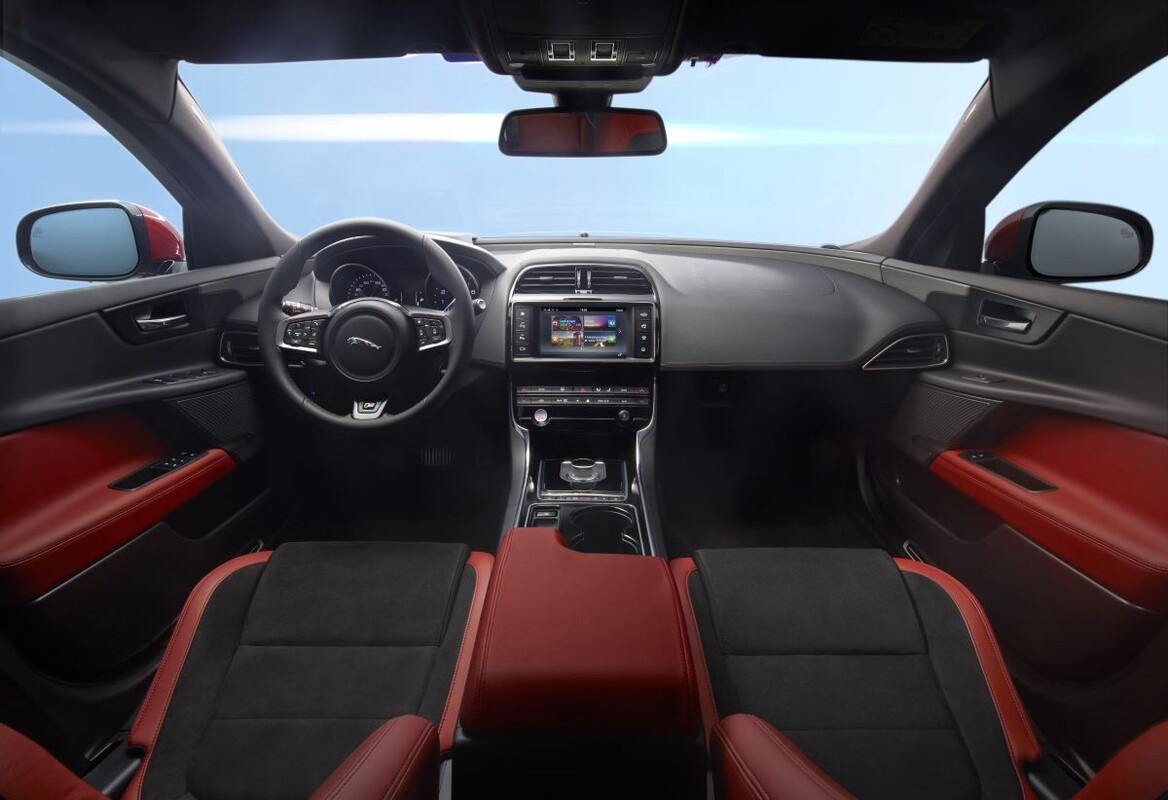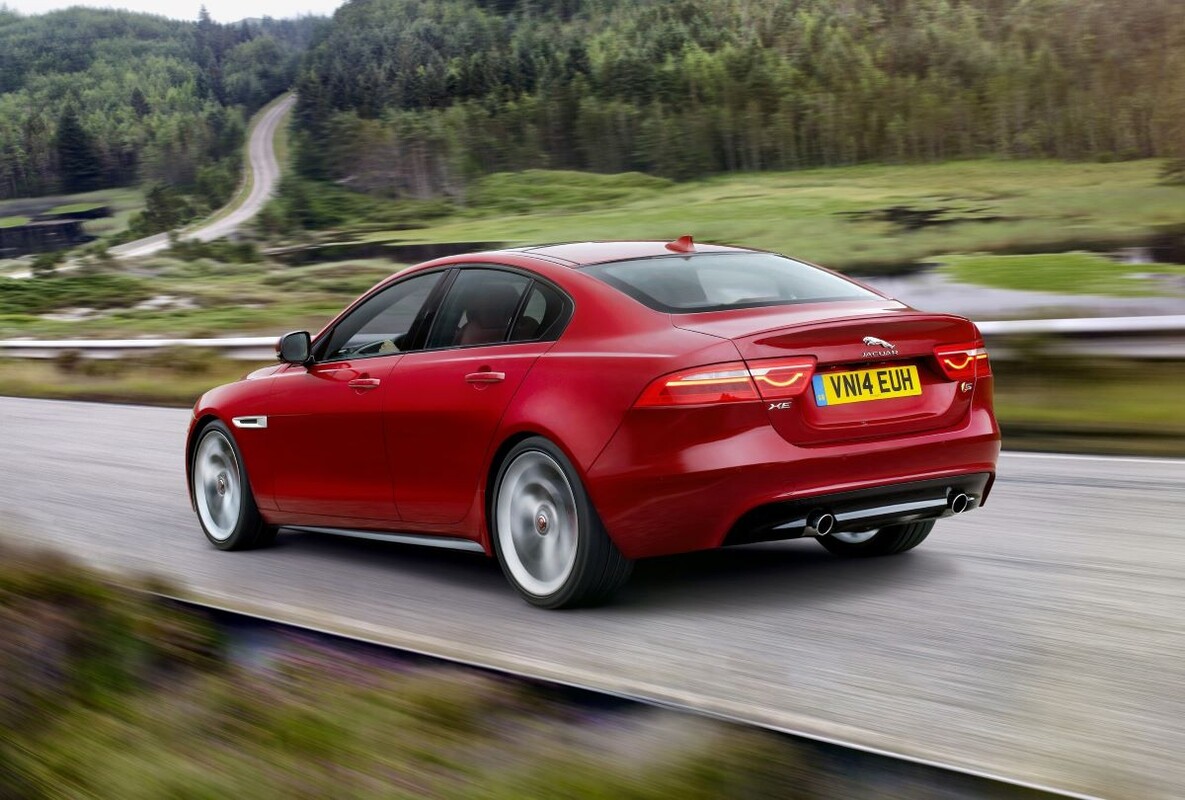
RAC sale – up to 33% off*
• Roadside cover from £5.29 a month†
• We get to most breakdowns in 60 mins or less
• Our patrols fix 4/5 breakdowns on the spot

Things you'll like
- Very good to drive
- Plenty of standard kit
- Relatively affordable used buy
Things to consider
- Back seats are tight for adults
- Interior of early cars could be more solid
- Ingenium engine reliability issues
History: What is the 2015-2019 Jaguar XE?
Jaguar is undergoing yet another revival, this time with its sights set on becoming an EV-only luxury brand. But there was a time – not that long ago – that going against the big-selling premium German brands was the priority.
In the late 2000s Jaguar was basking in the relative success of the XF. That BMW 5 Series-sized model was a key part of a new era for the brand, shedding its traditional retro image in the form of a thoroughly modern-looking executive car.
The problem was that the biggest sales volumes were in the smaller ‘compact executive’ class – a class all but sewn up by the BMW 3 Series, Audi A4 and Mercedes-Benz C-Class. All that Jaguar has to compete was the Mondeo-based X-Type, which didn’t really cut the mustard when new and was truly outdated by 2010.
It took investment from Jaguar’s new owners, Tata, to bring a truly competitive small saloon to market with the XE. Unlike the first-gen XF (which shared much with the old S-Type) the XE was a brand-new design with 75% aluminium construction, advanced suspension and high-tech new ‘Ingenium’ engines.
Despite billions of pounds spent and high expectations of sales of the XE never hit the heights Jaguar really needed. But does that make the small Jag an appealingly left field used buy? We’ll examine all in our Jaguar XE used review.
Verdict: is the Jaguar XE a good car?
We reckon the style, driving experience and sheer value of the Jaguar XE makes it an appealing used car – but buy with care. Diesels are best treated with caution due to the potential for expensive reported issues. It certainly isn’t the roomiest, nor the most high-tech choice in the premium small saloon segment, but its charm is undeniable.
Specs and used pricing
The key trim levels offered in the XE from launch until its facelift in 2019 included the fleet-friendly entry-level SE, posher Prestige, racier-looking R-Sport and fully-loaded Portfolio models, plus the flagship XE S with its punchy supercharged V6 engine.
SE trim comes only with cloth seats, but also features 17-inch alloys, an 18-inch touchscreen with sat-nav, Bluetooth, DAB and voice control, cruise control, auto lights and wipers, rear parking sensors and various safety ads including autonomous emergency braking, lane departure warning and traffic sign recognition.

Opting for the XE Prestige brings contrast-stitched leather upholstery, along with brushed aluminium dash trim and heated front seats. R-Sport upgrades the wheel size to 18 inches while also adding a bodykit, perforated leather sports seats, a faux leather dash, xenon headlamps, sports suspension and ambient cabin lighting.
Topping the ‘standard’ range, the Portfolio receives niceties like upgraded soft-grain leather trim, front seats with 10 way electric adjustment, chromed vents and a 380-watt Meridian sound system. The XE S gets an even sportier bodykit than R-Sport, all the extras of Portfolio, plus further luxury bits such as keyless start, adaptive dynamics and a powered boot lid.
When buying an XE used you’ll notice that the vast majority of examples are 2.0-litre diesels in Prestige or R-Sport spec with an automatic gearbox. Petrols aren’t hard to find, but manual gearboxes are.
You needed upwards of £27,000 to get into an XE when new, but a decade later just £5,000 will get you in a leggy SE 2.0d model with well north of 100,000 miles and a few battle scars. That makes the Jaguar look strong value next to similarly aged German competition.
Really, though, you’ll wanted to be spending at least £7,500 for a good condition example of average mileage, or £10k for a clean Portfolio model with a few options boxes ticked. £12k is enough to get you in one of the last pre-facelift 2019 examples in high spec or immaculate condition.
Meanwhile, the 3.0 V6 XE S starts from around £9,000 for a tatty high mileage example, all the way up to £23,000 for a well-optioned, low-mileage model from a top-tier dealer.
Rivals
The all-conquering German trio - the BMW 3 Series, Audi A4 and Mercedes-Benz C-Class – are easy to find on the used market and offer a more conventionally appealing alternative to the Jaguar. But if you still want some of the XE’s offbeat appeal then consider the Alfa Romeo Giulia as a likeable alternative.
Other options include the Volvo S60, the petrol or hybrid-only Lexus IS and the Maserati Ghibli. Late examples of the reliable Honda Accord are also worth considering, while if badge appeal matters less the Mazda 6, Vauxhall Insignia and Ford Mondeo all offer more car for less outlay.
Interior and practicality
The XE’s interior perhaps didn’t hit the heady heights of the first-generation XF, lacking that car’s sense of occasion and cool rotating air vents. But the rising rotary gear selector remains, as do some well-chosen design details and materials.
Overall even the cheapest XE retains a mostly premium air, but finishes and upholstery gets more lavish further up the range. Quality is a mixed bag, however – early cars suffered from fit and finish issues and elements of poor materials, but the newer the car the more upmarket the cabin tends to feel.
There are no complaints regarding the driving position, however. It’s low-slung and sporty, with well-placed controls and decent visibility. We also like the sporty and easy to read cowled dials, plus the extensive use of physical switchgear to complement the touchscreen.
Speaking of the touchscreen, the standard eight-inch system is usable and features handy shortcut buttons but seems dated by modern standards, with sluggish response times and so-so resolution. A larger 10.2-inch touchscreen was optional, though while this is an improvement on all fronts it can’t match BMW’s iDrive system for ease-of-use.

Passenger space, storage and boot space
One of the XE’s biggest failings is rear passenger space: it’s surprisingly cramped back there even by small saloon standards.
Headroom is the biggest issue, with the svelte sloping roofline meaning six-footers will have a hard time getting comfortable for anything other than short journeys – three across the back is a real stretch. Legroom isn’t overly generous either, but at least space up front isn’t an issue.
Cabin storage is fine, with some cupholders, a decent glovebox and door bins that are a reasonable size. The boot, meanwhile, is small by class standards at 410 litres, with a narrow opening and awkward shape impacting its usefulness. Treat it as a four-door sports car and it’ll be fine, but this is no out-and-out family car.
What is a used Jaguar XE like to drive?
Jaguar’s big sell with the XE was that it could convincingly feel like a four-door F-Type on the right road. And while that might be a bit of a stretch, it can certainly give the great-driving 3 Series a run for its money.
The XE is far nimbler and more willing to change direction than Jaguar saloons of old. Quick, feelsome steering, plenty of grip and a real feeling of composure means it’s one of the most confidence-inspiring cars in its class to thread down a twisty road.
Being a Jaguar, that combines with a ride that’s firm but well controlled, rounding off the worst potholes without sending too much of a jolt into the cabin. AWD models also add all-weather security, at the slight expense of handling feel.
Complaints? Well, the automatic gearbox isn’t always the speediest to kick down or change up, needing to be in Dynamic mode to avoid feeling lazy. It’s also best to avoid the largest wheel sizes for the plushest, quietest motorway ride, but that applies to all of the XE’s rivals too.
Engines
The XE was the first Jaguar to feature a range of all-new, British-built ‘Ingenium’ diesel engines, and although concerns around diesel emissions were becoming louder these were the most popular units for most of the car’s life.
The 2.0-litre four-cylinder ‘20d’ units were available in two states of tune initially: an entry-level 163hp version and a more desirable 180hp version with another 50Nm of torque over the base model. The latter was also available with all-wheel drive on certain model years.
While the base version wasn’t completely gutless with a 0-62mph time of 9.4 seconds, the 180hp unit was the pick of the range with a more effortless, ‘Jaguar-like’ level of performance combined with the slick-shifting eight-speed ZF automatic gearbox (or more rarely a six-speed manual ‘box).
Later there was also a twin-turbo ‘25d’ version offering a stout 250hp and 500Nm of torque, enough to take the 0-62mph time down to 6.5 seconds. It’s more difficult to find on the used market, but worth seeking out.
Petrol engines get a bit more confusing. Until 2017 the XE used Ford’s ‘EcoBoost’ turbo petrol four-cylinder units: a 200hp one in the 20t and a 240hp on in the 25t. These were serviceable engines but weren’t the strongest performing nor smoothest or most efficient when compared with German-brand equivalents.
If budget allows we’d stretch to the 2017-on Ingenium petrols. The base unit had the same name and power output as the old engine but improved efficiency, while the 25t was boosted to 250hp managed 0-62mph in 6.5 seconds.
If that wasn’t enough, there was two higher output petrols: the four-cylinder 30t was another Ingenium unit added from 2017, with power boosted to 300hp and a punchy 0-62mph time of 5.7 seconds. But the real hot ticket was the XE S.
This used Jaguar’s tried-and-tested ‘AJ’ V6 with a supercharger (also found in the F-Type sports car). Initially with an ample 340hp, it was boosted to 380hp in 2017, where its 0-62mph time of 4.8 seconds made it a strong and melodic powerplant – and one that’s appealingly affordable used. All petrol engines were mated to the ZF eight-speed automatic.
While BMW, Audi and Mercedes-Benz all went one step further with M, AMG and RS-tuned models – Alfa Romeo also joined in with the bonkers Giulia Quadrifoglio – Jaguar’s hottest XE proposition was a bit different. Named the ‘Project 8’, it did finally bring the much-loved 5.0-litre supercharged V8 to the XE, but limited to only 300 examples and with an extremely high price.

Ownership, running costs and reliability
It’s not hard to see why the diesels were in the hottest demand for the XE when on-paper efficiency is considered. The Ingenium units were far more economical but just as strong performers.
The entry-level 163hp diesel in manual form was by far and away the most economical Jaguar yet produced, promising a remarkable 75mpg and CO2 emissions below the magic 100g/km barrier. That only drops slightly for the automatic. However, it’s worth remembering that these figures were achieved under the older, less realistic NEDC test cycle rather than the more realistic WLTP regime.
In 180hp form on paper figures aren’t quite as seductive, falling to 67.3mpg and 109g/km of CO2. The 25d of 2017 promised 54.4mpg combined, a somewhat significant drop on paper.
The early petrols, meanwhile, were definitely on the thirsty side. Both the old Ford-sourced 2.0-litre units manages just 37.7mpg combined, only slightly up on the full-fat XE S’s 34.9mpg. The later Ingenium 2.0-litre units fared much better, promising 45mpg.
Jaguars of the 20th century tended to have a less-than-stellar reliability reputation in the 20th century, but things improved significantly throughout the 2000s. Sadly, the XE’s reliability reports are mixed at best.
The primary source of issues seems to be the Ingenium diesel engines. These can reportedly suffer from a litany of woes: timing chain failure, oil dilution, turbo failures, fuel injector issues and (as is often the case with modern diesel engines) DPF regeneration problems.
All of these problems are widely reported, and while it’s likely that many will have been addressed by owners over the years, they do still crop up. Happily, Jaguar specialists are aware of what to look for and how to deal with these issues. If you’re looking to buy a diesel XE, it’s well worth getting a vehicle inspection.
By comparison, the petrols seem to throw up fewer issues according to reports. Camshaft solenoids can fail on the Ingenium units, but the V6 in the S seems to be the most durable of the lot.
That said, other Jaguar-specific issues have been reported with the XE, including electrical gremlins and touchscreen faults. But, really, it’s the diesel engines that are the biggest potential weak link.
We'd also add the usual caveats: a full service history is an essential item on a mechanically complex car such as this, while checking the condition of the brake pads and discs and ensuring the battery is healthy can ensure unwanted bills don't quickly crop up.
Euro NCAP: is a used Jaguar XE a safe car?
The XE’s strong structure and standard safety aids made it a strong performer when it was crash tested by Euro NCAP in 2015.
Although the rating has expired due to its age, its performance matched up with the competition, delivering an impressive 92% rating for adult occupant protection. That’s on a par with the German alternatives.
Standard kit across the range such as lane departure warning, autonomous emergency braking and traffic sign recognition set the standard of the time, when such features weren’t mandatory.
Jaguar XE FAQs
Is the 2015-2019 Jaguar XE a good car?
The Jaguar XE is a good value used sports saloon that drives well, looks great, has lots of standard kit and won’t break the bank to buy. It’s not the most spacious or frugal option, however, while quality issues on early cars and reliability concerns mean you should buy with car.
Which is bigger, the Jaguar XE or XF?
The XE is the smallest saloon that Jaguar makes, with dimensions of 4678mm in length, 1850mm in width and 1416mm in height. It’s considerable shorter than the XF.
Is there any problems with the Jaguar XE?
There are numerous reported issues with the XE, mainly surrounding the diesel engine which can suffer from timing chain failure, turbo issues and oil dilution among other things. Electrical gremlins and faulty touchscreens weren’t unheard of, either, so buy with care.











![Mercedes-Benz C-Class [W205] (2014 - 2018) used car review](https://d1gymyavdvyjgt.cloudfront.net/drive/images/made/drive/images/remote/https_d2yv47kjv2gmpz.cloudfront.net/filestore/3/6/9/1_66e6feb0a99732c/a8aa96b24ca0d4f81142d091e41b09a7/1963_e91887a3452b078_100_100_70_c1_c_c.jpg)
